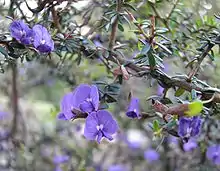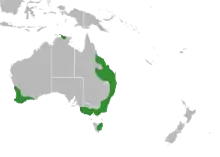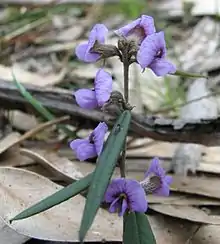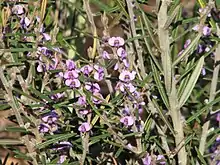Hovea
Hovea (Purple pea) is a genus of perennial shrubs which are native to Australia. Species from this genus are occasionally cultivated as ornamental plants. The genus name honours Anton Pantaleon Hove, a Polish plant collector.
| Hovea | |
|---|---|
 | |
| Hovea acanthoclada | |
| Scientific classification | |
| Kingdom: | |
| (unranked): | |
| (unranked): | |
| (unranked): | |
| Order: | |
| Family: | |
| Subfamily: | |
| Tribe: | |
| Genus: | Hovea |
| Species | |
|
See text. | |
 | |
| Range of Hovea[4] | |
| Synonyms | |
| |
Species
Hovea comprises the following species:[5][6][7]
- Hovea acanthoclada (Turcz.) F.Muell.—Thorny Hovea[8]
- Hovea acutifolia A. Cunn. ex G. Don—Northern Hovea[9]
- Hovea angustissima I. Thomps.
- Hovea apiculata A. Cunn. ex G.Don
- Hovea arnhemica J.H. Ross
- Hovea asperifolia I. Thomps.
- Hovea chorizemifolia DC.—Holly-leaved Hovea[8]
- Hovea clavata I. Thomps.
- Hovea corrickiae J.H. Ross
- Hovea cymbiformis I. Thomps.
- Hovea densivellosa I. Thomps.
- Hovea elliptica (Sm.) DC.—Tree Hovea[8]
- Hovea graniticola I. Thomps.
- Hovea heterophylla A. Cunn. ex Hook. f.
- Hovea impressinerva I. Thomps.
- Hovea lanceolata Sims
- Hovea linearis (Sm.) R. Br.—Common Hovea[10]
- Hovea longifolia R. Br.—Rusty Pods,[11] Long-leaf Hovea[12]
- Hovea longipes Benth.
- Hovea lorata I. Thomps.
- Hovea magnibractea I. Thomps.
- Hovea montana (Hook. f.) J.H. Ross—Mountain Hovea, Alpine Rusty-pods, Alpine Hovea[10]
- Hovea nana I. Thomps. & J.H. Ross
- Hovea nitida I. Thomps.
- Hovea pannosa A. Cunn. ex Hook. f.
- Hovea parvicalyx I. Thomps.
- Hovea pedunculata I. Thomps. & J.H. Ross
- Hovea planifolia (Domin) J.H. Ross
- Hovea pungens Benth.—Devil's Pins[8]
- Hovea purpurea Sweet
- Hovea ramulosa A. Cunn. ex Lindl.
- Hovea rosmarinifolia A. Cunn.—Mountain Beauty[10]
- Hovea similis I. Thomps.
- Hovea speciosa I. Thomps.
- Hovea stricta Meissner
- Hovea tasmanica I. Thomps. & J.H. Ross
- Hovea tholiformis I. Thomps.
- Hovea trisperma Benth.—Common Hovea[8]
References
- de Queiroz LP, Lewis GP, Wojciechowski MF (2010). "Tabaroa, a new genus of Leguminosae tribe Brongniartieae from Brazil". Kew Bull. 65 (2): 189–203. doi:10.1007/s12225-010-9202-7. JSTOR 23216080. S2CID 36238640.
- Cardoso D, Pennington RT, de Queiroz LP, Boatwright JS, Van Wyk BE, Wojciechowski MF, Lavin M (2013). "Reconstructing the deep-branching relationships of the papilionoid legumes". S Afr J Bot. 89: 58–75. doi:10.1016/j.sajb.2013.05.001.
- "Hovea". Australian Plant Census. Retrieved 2 May 2019.
- Thompson IR, Ladiges PY, Ross JH (2001). "Phylogenetic studies of the tribe Brongniartieae (Fabaceae) using nuclear DNA (ITS-1) and morphological data". Syst Bot. 26 (3): 557–570. doi:10.1043/0363-6445-26.3.557 (inactive 10 January 2021). JSTOR 3093981.CS1 maint: DOI inactive as of January 2021 (link)
- "APNI entry for Hovea". Australian Plant Name Index (APNI), IBIS database. Centre for Plant Biodiversity Research, Australian Government, Canberra. Retrieved 2 August 2009.
- "ILDIS LegumeWeb entry for Hovea". International Legume Database & Information Service. Cardiff School of Computer Science & Informatics. Retrieved 21 February 2014.
- USDA; ARS; National Genetic Resources Program. "GRIN species records of Hovea". Germplasm Resources Information Network—(GRIN) [Online Database]. National Germplasm Resources Laboratory, Beltsville, Maryland. Retrieved 21 February 2014.
- "Hovea". FloraBase. Western Australian Government Department of Parks and Wildlife.
- Greig, D. (1987). The Australian Gardener's Wildflower Catalogue. Australia: Angus & Robertson. ISBN 978-0207154607.
- Cochrane, G.R.; Fuhrer, B.A.; Rotherdam, E.M.; Simmons, J.; Simmons, M. & Willis, J.H. (1980). Flowers and Plants of Victoria and Tasmania. A.H. & A.W. Reed. ISBN 978-0589502560.
- "Genus Hovea". PlantNET - New South Wales Flora Online. Royal Botanic Gardens & Domain Trust, Sydney Australia. Retrieved 2 August 2009.
- Costermans, L. (1981). Native Trees and Shrubs of South-eastern Australia. Australia: Rigby. ISBN 978-0727014030.
This article is issued from Wikipedia. The text is licensed under Creative Commons - Attribution - Sharealike. Additional terms may apply for the media files.


